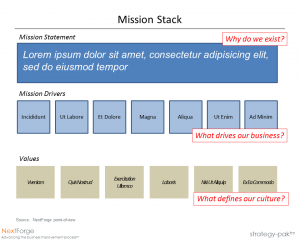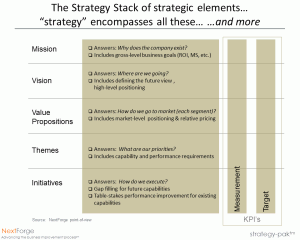“Three Rules of Work: Out of clutter find simplicity; From discord find harmony; In the middle of difficulty lies opportunity.” Albert Einstein
 Seldom do we have the opportunity to help a client with strategic architecture from a clean slate as we recently completed with ABC. More typically we have used a comprehensive view, our strategy-paksm, to find “What is missing?” The reason companies often take a more piecemeal approach is at least two-fold. First, strategy, like the world we compete in, is complex. Second, most successful companies have the whole cloth of their historic strategy. Perhaps with a need for some renovation, perhaps with the need for recutting to fit the current fashion, occasionally in need a bit of mending to fill-in some holes, but seldom are we asked to knit the whole cloth of strategy from, for example, a few bits of culture (more on culture later).
Seldom do we have the opportunity to help a client with strategic architecture from a clean slate as we recently completed with ABC. More typically we have used a comprehensive view, our strategy-paksm, to find “What is missing?” The reason companies often take a more piecemeal approach is at least two-fold. First, strategy, like the world we compete in, is complex. Second, most successful companies have the whole cloth of their historic strategy. Perhaps with a need for some renovation, perhaps with the need for recutting to fit the current fashion, occasionally in need a bit of mending to fill-in some holes, but seldom are we asked to knit the whole cloth of strategy from, for example, a few bits of culture (more on culture later).
In the following, we will share with you the structure, the warp and the weft of the whole cloth, of strategy. We have used this strategy stack to guide our work for more than a decade and a half to tailor, to repair, to clean, and, occasionally, to rigorously provide the foundational elements of integrated guidance for a publicly traded company.
Out of clutter find simplicity
 The strategy stack is a 5-level hierarchical organizing concept of a number of commonly used strategic elements. Over time many of these conceptual monikers have picked up ambiguous and conflicting meanings. We find a focusing question helps side-step engrained beliefs and get to the critical elements of direction.
The strategy stack is a 5-level hierarchical organizing concept of a number of commonly used strategic elements. Over time many of these conceptual monikers have picked up ambiguous and conflicting meanings. We find a focusing question helps side-step engrained beliefs and get to the critical elements of direction.
Mission
Includes: Gross-level business elements (ROI, market share, etc.), Consider softer ( à la balanced scorecard) elements
Mission is unique among the strategy stack elements and breaks down into its own Mission Stack (three level sub-stack)
 Mission Statement
Mission Statement
Focusing question: Why does the company exist?
Business Drivers
Focusing question: What things done right will ensure our success in the marketplace?
Culture
Focusing question: What core values define how we work together and how we work with others?
A side bar- P&G relies on purpose, values and principles to guide their company. According to survey responses of nearly 1,000 P&G alumni world-wide, the following values were mentioned by the respondents (% response) as contributing to their personal success and the success of the companies they have worked with since P&G: doing the right thing (77%); respect for the contributions of others (66%); merit determined by performance (57%); honest evaluation of causes of poor performance (53%); and Concern for the well-being of partners, customers and community (49%)1.
Vision
Focusing question: Where are we going?
Includes: Defining a view of the future, high level positioning
 Value Proposition
Value Proposition
Focusing question: How do we go to market with our target segment(s)?
Includes: Market-level positioning and relative pricing, understanding of value derived from our offering (product and service package) from a customer’s perspective
Themes
Focusing question: What are our priorities?
Includes: Capability and performance requirements
Initiatives
Focusing question: How do we execute?
Includes: Gap-filling projects for future capabilities and table-stakes performance improvement projects for existing capabilities with both types of initiatives driven by prioritized themes
Key Performance Indicators
Each level of the hierarchy provides an opportunity for key performance indicators (KPIs). We break the KPI’s down into two parts:
Measure: What is to be measured e.g., gross margin
Target: Numeric target to be achieved e.g., 50% gross margin
A side bar on the Balanced Scorecard- ABC, and other clients we have been involved with, have historically had trouble with KPI’s by 1) diving too deep- defining too may KPIs (or as we referred to lesser performance indicators, PIs) and 2) getting wrapped around the axle within Kaplan and Norton’s Balanced Scorecard2 hierarchy (Financial, Customer, Internal and Learning). We have, as we did with ABC, consistently recommended to start with just one or two KPIs for up to 7 of the business drivers. Further, we suggest starting with the no over-arching priority of the drivers, but rather have each organizational unit determined how they can best contribute to each of the enterprise drivers as they are cascaded down through the organization.
From discord find harmony
We encourage diversity and breadth of involvement in the strategy stack formulation for two key reasons: rigor of solution, and anchoring initial direction for change management. Much of the leading thinking on social business leverages tools which allow leadership to look to the fringe of the enterprise, the customer and competitive hard-face, for ideas to inform the planning process. For example, ABC included a large management team (double typical span of controls) to include the diversity of thought from operations to the legal to sales to communications to environmental to financial.
Additionally, when the c-level leadership team at ABC went out into the field to begin the communication of new direction through town-hall type events, they started each meeting by introducing themselves (including to the other floors of the home office). Later during the town hall, they solicited and were met with very direct, frank and unflattering feedback. But these initial steps led to a very successful wave of enthusiasm in the work of cascading the drivers and operating/functional organization’s KPIs. And, a representative group of the employees volunteered to define the values initially outlined by the ABC’s leadership team.
 In the middle of difficulty lies opportunity
In the middle of difficulty lies opportunity
Like ABC’s story, hardship and competitive pressure can provide a compelling need for change (see the change formula). As a matter of fact we believe the articulation of the need for change needs to be included “at the top” of the strategy stack and is critically necessary to drive behavioral change and support the heavy lifting required at the “lower levels” of the strategy stack.
Communication of key transformation messages were supported at ABC through, for example, SharePoint sites providing the executive team with content (e.g., talking points), scheduling and administration. Also video clips of the leadership team were produced to be used on break room large screens at more than 100 plants and facilities. Where one of the c-level executives had visited the plant, these video messages helped reinforce their live appearance. Where the leadership team was not able to visit during their initial town hall rotation, the videos provided complementary messaging to supervisor lead discussions (again, aided by talking points).
This is the third post in a definitional series on the key elements of strategy. We will continue to include a few observations along the way on how we have, or might, advance the more traditional concepts. Collectively, we refer to the grouping of strategic concepts as the strategy-paksm.
1 See Tocquigny and Butcher, When Core Values Are Strategic (Upper Saddle River, NJ: FT Press, 2012)
2 See Kaplan and Norton, Strategy Maps: Converting intangible assets into tangible outcomes (Boston: HBS Press, 2004)

